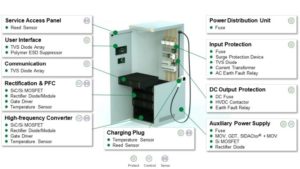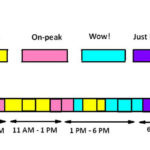Several standards dictate safety measures that fast charging stations must employ.
Philippe Di Fulvio, Littelfuse, Inc.
An estimated 5.5 million electric vehicles (EVs) were on the road in 2020. By 2025, the expectation is that over 24 million EVs will be in use. A significant limitation to wider EV adoption is the public charging infrastructure required to support long-distance travel. In 2019, only 7.3 million chargers existed worldwide with less than a million available for public access. Few of these chargers could recharge an EV in a time frame anywhere near that of filling the gas tank of an internal combustion vehicle.
Today, the latest high-power, dc charging technology can handle battery charging in under 30 minutes. As more fast-charging stations become available, the adoption of EVs will also accelerate.
Clearly, design engineers face multiple challenges in developing EV charging stations. Most important is that of safety, as users must interface with over 300 kW of charging station power. Other important design parameters include high efficiency to reduce both power consumption and maximum temperature rise. Outdoor recharging stations must perform reliably despite exposure to a wide range of environmental conditions.

There are three types of commercial charging stations. In North America, charging stations are classified into “Levels” while the European Union differentiates charging stations using “Modes.” The AC Level 1 charging station, with the in-cable control box (ICCB), is intended for charging at a residential home. The AC level 2 can be either a home or a public installation. The third type is a DC Fast Charging Station used in public and commercial settings. Organizations such as the Society of Automotive Engineers, the European Union automotive standards organization, and Asian counties such as Japan and China are trying to standardize charging stations.
The DC Fast Charger (Mode 4) is designed to charge an EV battery to 80% capacity in under 30 minutes. These chargers have power ratings up to 350 kW and can supply up to 400 A to a battery. Mode 4 chargers present special design challenges in keeping the charger cables cool and preventing ground currents. But they are of high interest today because their charging time is shorter than the alternatives.
Compared to ac charging systems, the dc charging station has the added complexity of ac-dc power conversion. When designing with tens of hundreds of kilowatts of power, it is essential that dc charging station designers particularly emphasize efficient power conversion, reliability, and user safety.
Power distribution unit
At the connection to the ac source, the dc charger requires protection from overload currents and short circuit conditions with a fast-acting, high current fuse. The fuse must have a current interrupting rating large enough to ensure it exceeds the energy available from the ac line. Some fuses can have ratings up to 200 kA.

The main protection from current overloads and voltage transients comes from the Input Protection circuit. It should incorporate a fast-acting fuse to protect downstream sensitive circuitry. As with the ac charging station, it should also contain surge-protection measures to withstand high-energy transients. Instead of using a surge-protection device, consider a power TVS diode for fast response and low voltage clamping. A TVS diode can also serve as a secondary level of protection accompanying a primary surge protector.
One essential requirement for three-phase power sources is a monitoring facility for a fault in the power system ground. The recommended way of monitoring current in the ground line is via a current transformer. The current transformer should be able to detect under 30 mA and should incorporate flux conditioning to avoid saturation. Use a ground-fault protection relay to measure the current from the current sensor and disconnect the input power in the event a high ground current is detected.
Let us now turn to the rectifier and power factor correction (PFC) function. Bridgeless PFC circuits seek to minimize the number of semiconductor devices in the active current loop at any time to minimize power losses and maximize efficiency. If the ac power source is three-phase for a high-power dc charger, the topology is known as Vienna or a boost-stage topology.
Because the dc charger is a high-power system, even small improvements in efficiency bring significant savings in power consumption. Use of Schottky rectifier diodes or diode modules reduces turn-on voltage requirements. Along with low forward voltage, look for diodes exhibiting low leakage current. Select individual diodes or use diode modules if the component count is a critical concern.
Use of silicon MOSFETs, SiC MOSFETs, or IGBTs can all maximize the efficiency of the rectifier and PFC circuit. Silicon and SiC MOSFETs exhibit fast switching rates and enable higher frequency operation. Use of higher switching frequencies reduces inductor size which in turn improves efficiency. Of course, transistor temperature should be monitored to prevent excessively high junction temperatures.
Consider using a gate driver chip to control the power transistors. Gate drivers can operate the transistors at a high switching frequency and consume little power while providing drive currents as high as 30 A. There are both inverting and non-inverting versions. In a nutshell, gate driver chips simplify the task of controlling power MOSFETs and IGBTs.
The full bridge, resonant, and gate driver circuits should use the same protection components suggested for the rectifier and PFC circuitry. These components help to minimize power losses in the whole ac-dc conversion block.
DC output
The dc output should use a fast-responding high-current, high-voltage-rated fuse to protect the output circuitry from overheating. The CHAdeMO (CHArge de MOve) Association promotes a fast-charging infrastructure for dc charging that calls for a reverse-flow protection diode in the secondary rectifier. This diode serves as redundant protection

against a short condition. Finally, control the output to the vehicle with a high-voltage dc contactor. This should be an IP-67-rated, gas-filled contactor both to mitigate arcing and to prevent moisture and dust ingress.
The DC-Earth-Fault Protection circuit monitors for ground faults on ungrounded systems. Select a dc ground-fault monitor with an adjustable alarm threshold limit and an adjustable trip delay to avoid nuisance activation of the relay. Use a ground reference module—basically, a two-element resistor network which, with the ground-fault monitor, is designed to detect when either the high or low output lines short to earth ground. The contacts of the high-voltage dc contactor open to prevent damage to the vehicle’s battery circuitry and the charger circuitry.
The Charging Plug Position/Temp circuit is another significant safety circuit. Both dc and ac chargers should use the same temperature and proximity sensors.
In the ac-dc converter for the logic and control circuitry, use of Schottky diode rectifiers and high-power MOSFETs with high-speed switching minimize power loss and maximizing efficiency. The MOSFETs have a low RDS(On) which reduces power consumption when the MOSFET is conducting.
Standards bodies require a fuse in the Auxiliary Power Supply. Transient protection can come from either a MOV-GDT combination identical to that in the ac charging station Input Protection circuit or a MOV-protection thyristor as recommended for the ac charging station Auxiliary Power Unit.
The Communication, User Interface, and Access Panel Sensors circuits perform the same functions in both dc and ac charging stations. Protect the data lines from ESD using the components recommended for the ac charger. Use the reed proximity sensor recommended for the AC Access Panel Sensors circuit in the dc charger circuit.
Because dc charging stations consume and deliver high power, they must meet several safety certifications. IEC 61851, UL 2594, and GB/T 18487 Series are the three primary standards that charging stations must meet.
Ensuring that charging circuits are both protected from environmental hazards and safe for user interaction complicates the job of designing EV charging stations. It is difficult to be an expert in all areas of dc charging station design. Fortunately, manufacturers of protection products can offer design recommendations and help save development time. Application engineers can provide useful advice on the tradeoffs between power/volume, efficiency, and component costs. Some manufacturers will also assist with standards compliance and can offer pre-compliance testing services.
References
Supercharged Solutions for EV Charging Stations Guide







It certainly caught my attention when you informed us that the DC fast charger or otherwise known as Mode 4 can charge the battery of an electrical vehicle up to 80% capacity in just under 30 minutes with power ratings up to 50 kW. My brother recently invested in an EV, so he needs a charger outlet installed in his home in Atlanta soon. I’ll keep this in mind while I look for an electrician I can recommend to him for the outlet installation soon.